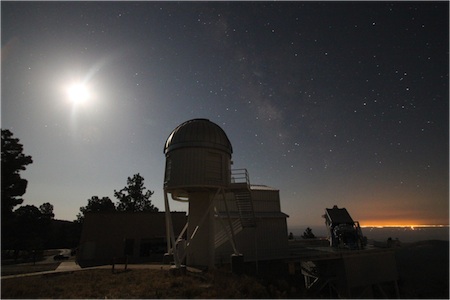DR15 APOGEE Survey and Instruments Overview

Image Credit: S. R. Majewski
APOGEE performs a systematic survey of all of the Milky Way stellar components using high-resolution, multi-object, near-infrared spectroscopy.
The APOGEE Survey
The first installment of the APOGEE Survey (APOGEE-1) was carried from September 2011 to July 2014. Observations were performed with the APOGEE-North spectrograph on the 2.5-meter Sloan Foundation Telescope and the 1-meter NMSU Telescope at Apache Point Observatory (APO) in New Mexico, USA. The second installment, APOGEE-2, will run through Summer 2020 and continues data acquisition with both telescopes at APO. Starting April 2017, observations are also being taken with the APOGEE-South spectrograph on the 2.5-meter Irénée du Pont Telescope of Las Campanas Observatory (LCO).
Each APOGEE instrument acquires simultaneous spectra of 300 science and calibration targets using the 2.5-meter telescopes. APOGEE-North is also capable of observing single stars (with a small number of sky calibration targets) using the 1-meter NMSU Telescope.
For most survey fields, observations are made of the same stars at multiple epochs to allow for the identification of binary stars via their radial velocity variation. Combined spectra of these multiple observations are one of APOGEE's primary data products. Stellar atmospheric parameters and chemical abundances are derived from these combined spectra using the APOGEE Stellar Parameters and Chemical Abundances Pipeline (ASPCAP).
These pages provide a brief introduction to the APOGEE survey and its data. See the APOGEE technical papers for detailed information on all aspects of the APOGEE survey in a format that you can cite in your work.
APOGEE Instruments
Both APOGEE spectrographs are 300-fiber cryogenic systems that were custom-built at the University of Virginia. See Wilson et al. (2012) and the APOGEE spectrographs page for more details.
APOGEE Spectral Data
Prior to Data Release 10, all of SDSS's spectroscopic data, including the stellar data from the SEGUE surveys, were taken with optical spectrographs.
APOGEE data sample the infrared portion of the electromagnetic spectrum, covering the H-band wavelength range of 1.5-1.7 microns (details of wavelength coverage). The relatively high resolution of the spectra — 10 times higher than the SDSS optical spectra — allows for measurement of the radial velocities, chemical compositions, and physical properties of the survey stars with greater precision and accuracy.
Starting with DR10, APOGEE data have been included in SDSS releases, with products spanning raw and reduced spectra through catalogs of radial velocities, derived stellar parameters, and elemental abundances.
Data Access
Catalog Archive Server (CAS)
APOGEE target information and derived radial velocities, stellar parameters, and elemental abundances are loaded into the Catalog Archive Server (CAS) database. CAS contains a number of ways of interfacing with the database, including low-level SQL access through the CasJobs portal that allows you to save and analyze all your search results.
Science Archive Server (SAS)
Summary FITS files containing the derived radial velocities, stellar parameters, and elemental abundances for all APOGEE stars, as well as all raw and processed APOGEE spectra, are available from the APOGEE Science Archive Server (SAS). The SAS mirrors the directories and files listed in the Data Model.
Science Archive Webapp (SAW)
SkyServer
The SkyServer Explore tool provides a quick way to find APOGEE spectra for a desired object. Quick Look shows an image and spectrum for all SDSS objects. For objects with APOGEE spectra, the tool includes an APOGEE section. The APOGEE section of the Explore tool shows a composite spectrum, radial velocities, and derived stellar atmospheric parameters, while also providing links to additional data, including the spectrum as a FITS file.
All APOGEE catalog data are available through the search tools of SkyServer. The Infrared Spectroscopy Query Form lets you search for APOGEE catalog objects by position, spectral classification, velocity, and other constraints in spectroscopy and/or imaging. SQL Search lets you create your own search using the SQL database programming language; see the SkyServer SQL Tutorial to learn how to write SQL queries.
Value-Added Catalogs (VACs)
In addition to the formal data products, the following Value-Added Catalogs (VACs) are available:
Additional Information and Links
The APOGEE Stellar Parameters and Chemical Abundances Pipeline (ASPCAP) determines stellar parameters and abundances through the automated analysis of APOGEE's high-resolution H-band spectra. ASPCAP derives the effective temperatures (Teff), surface gravities (log g), metallicities, microturbulent velocities, and multiple element abundances. Users interested in working with ASPCAP data are strongly advised to read the documentation in the Using APOGEE Stellar Parameters page and the Using APOGEE Chemical Abundances page, where uncertainties, potential systematic effects, and other important issues are discussed.
Observing and Data Use Information
- APOGEE Observing
- gives an overview of how APOGEE spectroscopic data are taken.
- APOGEE Data Access
- describes all of the APOGEE data products that are available through the Science Archive Server.
- Examples
- provides examples of how to query the database or summary data files in order to retrieve a variety of information for different types of targets.
- Using APOGEE Stellar Parameters
- describes things you need to know if you plan to use the derived stellar atmospheric parameters.
- Using APOGEE Chemical Abundances
- describes things you need to know if you plan to use the derived elemental abundances.
- Using APOGEE Spectra
- describes some features in APOGEE spectra about which anyone looking at spectra should be aware.
Software and Processing Information
- APOGEE Target Information
- describes the way in which APOGEE targets are chosen and how this is documented in the target flags.
- APOGEE Visit Spectra Reduction
- gives information about how individual visit spectra are observed, processed, and stored.
- APOGEE Visit Spectra Combination
- gives information about how the combined spectra for each star are created and stored.
- APOGEE Radial Velocities
- describes the derivation of radial velocities from both individual visit and final combined spectra.
- APOGEE Stellar Parameter and Abundance Determination
- describes how the stellar parameters and abundances available in APOGEE spectroscopic catalogs are derived.
- APOGEE Caveats
- gives a running list of known issues with this release.


